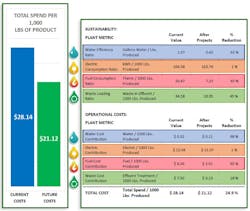Case study: Comprehensive site assessment results in reduced water and waste costs for cheese producer
Sartori Cheese, a Wisconsin-based world-class cheese producer known for its SarVecchio Parmesan and BellaVitano cheeses, collaborated with Kurita America to take a proactive approach to review its water consumption, production, cleaning practices and wastewater discharge at its production facility in Antigo, Wisconsin.
Through a comprehensive site assessment (CSA), and in alignment with the facility’s goals, the company improved sustainability and reduced water and waste costs.
Kurita America recommended a CSA, which is part of the assessment process (AP) model, to provide a robust, holistic examination of all water, energy and waste consumed and produced during operations. The reduction in the total cost of operations (TCO) aligns with sustainability goals while maintaining product and brand quality.
Kurita America was chosen to assess the water intensity of the Antigo plant based on its dairy industry application expertise and its range of water management solutions, including chemical, equipment and operational components.
During the initial assessment event that occurred over three days, baseline data was agreed upon, such as pounds of products being produced, water and energy waste, and production schedule. As many as nine Kurita America technical representatives made daily observations with site engineers and operators throughout the plant’s entire operation, while end-of-the-day meetings occurred to discuss key insights on activities, leaks and other issues. This allowed for a continuous improvement mindset to drive future opportunities. Water, fuel, electrical and waste data was collected, analyzed and rigorously evaluated with the team, helping to drive the TCO reductions and achieve sustainability goals. One senior Sartori associate said, “The amount of front-end work with the Kurita [America] team was instrumental in having good information to input.”
After the initial assessment was completed, there were multiple visits to the site and continued testing to verify accuracy of data and improve project valuations. These observations and visits concluded in proposed projects and potential savings for the facility.
Using the CSA model, the Sartori-Antigo team was presented an ever-evolving continuous improvement tool. An emphasis of the CSA is built around ensuring product quality was maintained while targeting specifically engineered solutions. Kurita America ensured that the proposed projects would not negatively impact Sartori’s products or manpower capabilities.
More than 10 projects were identified based on sustainability, operations and cost; the local and corporate Kurita America and Sartori teams worked to identify these as operational and capital initiatives. Some of these projects involved water heat exchangers, brine recovery, bioaugmentation, metering and monitoring, and wastewater optimization. The projects were ranked based on ease of implementation and categorized by the financial impact and return on investment (ROI). The resulting output from the Sartori Cheese CSA included
- 14 different improvement projects identified
- Potential water savings or water reuse of 35% or 22.3 million gallons annually
- Potential cost savings of over $870,000 in water, energy, and waste
Sartori management said, “It was invaluable to work with the Kurita [America] team to help identify opportunities through their CSA process. The output was a roadmap to success in sustainability for the plant.”
Results of the CSA
Since completion of the CSA, there have been regular cadence calls with Sartori Cheese members and the team at Kurita America on project updates and implementation reviews. At the time of this case study publication, seven projects have been completed at Sartori-Antigo to provide a cost savings of $220,697 annually. Another project is in the process of being completed for an added $58,893 in annual savings, bringing the total realized savings associated with the CSA to $279,590 annually.
The remainder of potential cost savings and sustainability opportunities are being reviewed and evaluated based on capital investment and feasibility of implementation. While these projects and solutions were specifically designed for Sartori-Antigo, the entire company can leverage similar projects and standardize initiatives throughout their multiple sites.
Kurita America’s CSA represents a holistic approach to water management designed to help business partners solve complex production, environmental and regulatory issues while mitigating risk, lowering costs and improving sustainability metrics.
Scott Fisher is a corporate account manager at Kurita America.
About the Author
Scott Fisher
Corporate Account Manager
Scott Fisher is a Corporate Account Manager with Kurita America.

